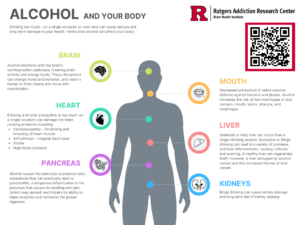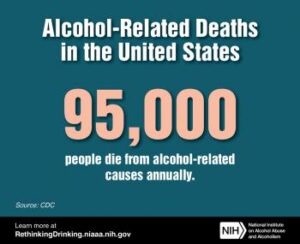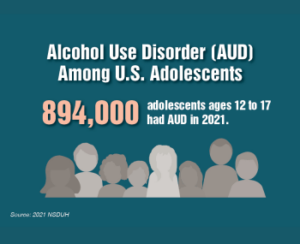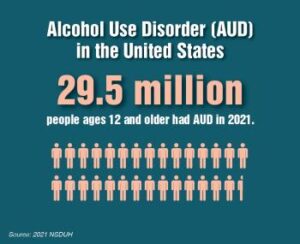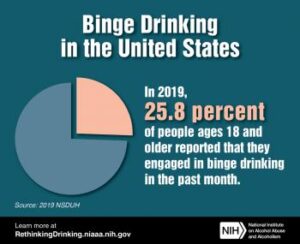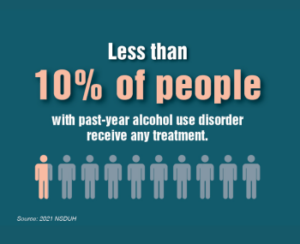Statistics on Alcohol Use Trends in the United States
Alcohol use disorder (AUD) is a medical condition characterized by an impaired ability to stop or control alcohol use despite adverse social, occupational, or health consequences. It encompasses the conditions that some people refer to as alcohol abuse, alcohol dependence, alcohol addiction, and the colloquial term, alcoholism*.
Prevalence of Drinking
According to the 2021 National Survey on Drug Use and Health (NSDUH), 84.0 percent of people ages 18 and older reported that they drank alcohol at some point in their lifetime,1 66.9 percent reported that they drank in the past year,2 and 51.7 percent (55.0 percent of men in this age group and 48.6 percent of women in this age group3) reported that they drank in the past month.3
Prevalence of Binge Drinking and Heavy Alcohol Use
In 2021, 23.3 percent of people ages 18 and older (25.7 percent of men in this age group and 20.9 percent of women in this age group4) reported that they engaged in binge drinking in the past month,4 and 6.4 percent (8.0 percent of men in this age group and 4.8 percent of women in this age group5) reported that they engaged in heavy alcohol use in the past month.5 (See glossary for definitions of binge drinking and heavy alcohol use.)
Emerging Trend—High-Intensity Drinking
High-intensity drinking is defined as consuming alcohol at levels that are two or more times the gender-specific binge drinking thresholds. (See glossary for additional details about the definition of high-intensity drinking). Compared with people who did not binge drink, people who drank alcohol at twice the gender-specific binge drinking thresholds were 70 times more likely to have an alcohol-related emergency department (ED) visit, and those who consumed alcohol at 3 times the gender-specific binge thresholds were 93 times more likely to have an alcohol-related ED visit.6
*Although the terms alcoholic and alcoholism are often used in discussions about heavy drinking, the science community has been moving away from these terms for years now. There are two primary reasons to use more nuanced terms: (1) Alcohol problems are not a “yes” or “no” issue. It’s important to remember that drinking problems can exist at any point on a scale between “none” and “severe.” (2) The term “Alcoholic” carries lots of cultural baggage and stigma. (https://www.smartrecovery.org/moving-away-from-the-terms-alcoholic-and-alcoholism/)
Glossary
A fatality in a crash involving a driver or motorcycle rider (operator) with a blood alcohol concentration (BAC) of 0.08 g/dL or more (*A BAC of 0.08 percent corresponds to 0.08 grams per deciliter, or 0.08 grams per 100 milliliters).
Drinking in a manner, situation, amount, or frequency that could cause harm to users or to those around them. For individuals younger than the legal drinking age of 21, or for pregnant females, any alcohol use constitutes alcohol misuse.
A chronic brain disorder marked by compulsive drinking, loss of control over alcohol use, and negative emotions when not drinking. AUD can be mild, moderate, or severe. Recovery is possible regardless of severity. The DSM-IV, published by the American Psychiatric Association, described two distinct disorders—alcohol abuse and alcohol dependence—with specific criteria for each. The fifth edition, DSM-5, integrates the two DSM-IV disorders into a single disorder called AUD, with mild, moderate, and severe subclassifications.
Treatment received at any location, such as a hospital (inpatient), rehabilitation facility (inpatient or outpatient), mental health center, ED, private doctor’s office, self-help group, or prison/jail.
- The National Institute on Alcohol Abuse and Alcoholism (NIAAA) defines binge drinking as a pattern of drinking that brings BAC levels to 0.08 g/dL or higher. This typically occurs after a woman consumes 4 or more drinks or a man consumes 5 or more drinks—in about 2 hours.
- The Substance Abuse and Mental Health Services Administration (SAMHSA), which conducts the annual NSDUH, defines binge drinking as consuming 5 or more alcoholic drinks for males or 4 or more alcoholic drinks for females on the same occasion (i.e., at the same time or within a couple of hours of each other) on at least 1 day in the past month.
- The Monitoring the Future (MTF) survey defines binge drinking as having 5 or more drinks in a row in the past 2 weeks.
A measure of years of life lost or lived in less than full health.
- NIAAA defines heavy drinking as follows:
- For men, consuming more than 4 drinks on any day or more than 14 drinks per week
- For women, consuming more than 3 drinks on any day or more than 7 drinks per week
- SAMHSA defines heavy alcohol use as binge drinking on 5 or more days in the past month.
- Consumption of 2 or more times the gender-specific thresholds for binge drinking, which is to say 10 or more standard drinks (or alcoholic drink-equivalents) for males and 8 or more for females. High-intensity drinking is consistent with drinking at binge levels II and III. The levels correspond to one to two times (I), two to three times (II), and three or more times (III) the standard gender-specific binge thresholds.
- The Monitoring The Future survey defines high-intensity drinking as consuming 10 or more or 15 or more drinks in a row in the past two weeks.
Binge drinking and heavy alcohol use can increase an individual’s risk of AUD. According to the Dietary Guidelines for Americans, 2020–2025, adults of legal drinking age can choose not to drink or to drink in moderation by limiting intake to 2 drinks or less in a day for men and 1 drink or less in a day for women, when alcohol is consumed. Drinking less is better for health than drinking more. Some individuals should avoid alcohol completely.
Alcohol use by anyone under the age of 21. In the United States, the legal drinking age is 21.
Source: https://www.niaaa.nih.gov/publications/brochures-and-fact-sheets/alcohol-facts-and-statistics
For more information, please visit: https://www.niaaa.nih.gov
1SAMHSA, Center for Behavioral Health Statistics and Quality. 2021 National Survey on Drug Use and Health. Table 2.25B—Alcohol use in lifetime: among people aged 12 or older; by age group and demographic characteristics, percentages, 2021. Available from: https://www.samhsa.gov/data/NSDUHDetTabsSect2pe2021.htm#tab2.25b
2SAMHSA, Center for Behavioral Health Statistics and Quality. 2021 National Survey on Drug Use and Health. Table 2.26B—Alcohol use in past year: among people aged 12 or older; by age group and demographic characteristics, percentages, 2021. Available from: https://www.samhsa.gov/data/NSDUHDetTabsSect2pe2021.htm#tab2.26b
3SAMHSA, Center for Behavioral Health Statistics and Quality. 2021 National Survey on Drug Use and Health. Table 2.27B—Alcohol use in past month: among people aged 12 or older; by age group and demographic characteristics, percentages, 2021. Available from: https://www.samhsa.gov/data/NSDUHDetTabsSect2pe2021.htm#tab2.27b
4SAMHSA, Center for Behavioral Health Statistics and Quality. 2021 National Survey on Drug Use and Health. Table 2.28B—Binge alcohol use in past month: among people aged 12 or older; by age group and demographic characteristics, percentages, 2021. Available from: https://www.samhsa.gov/data/NSDUHDet.htm#tab2.28b
5SAMHSA, Center for Behavioral Health Statistics and Quality. 2021 National Survey on Drug Use and Health. Table 2.29B—Heavy alcohol use in past month: among people aged 12 or older; by age group and demographic characteristics, percentages, 2021. Available from: https://www.samhsa.gov/data/NSDUHDet.htm
6Hingson RW, Zha W, White AM. Drinking beyond the binge threshold: predictors, consequences, and changes in the U.S. Am J Prev Med. 2017;52(6):717-27. PubMed PMID: 28526355


